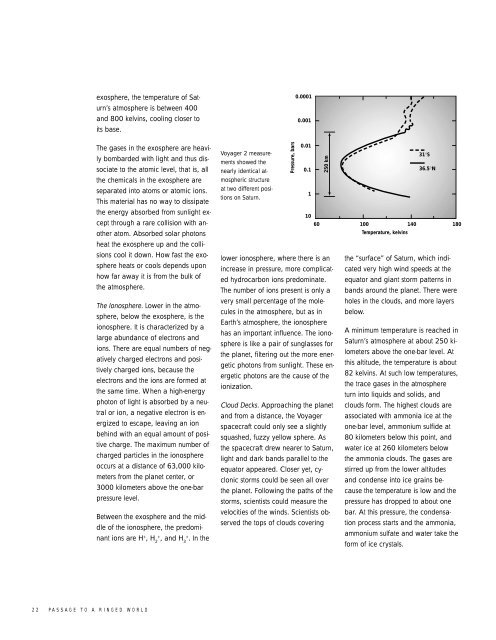Passage to a Ringed World - NASA's History Office
Passage to a Ringed World - NASA's History Office
Passage to a Ringed World - NASA's History Office
You also want an ePaper? Increase the reach of your titles
YUMPU automatically turns print PDFs into web optimized ePapers that Google loves.
exosphere, the temperature of Saturn’s<br />
atmosphere is between 400<br />
and 800 kelvins, cooling closer <strong>to</strong><br />
its base.<br />
22 PASSAGE TO A RINGED WORLD<br />
The gases in the exosphere are heavily<br />
bombarded with light and thus dissociate<br />
<strong>to</strong> the a<strong>to</strong>mic level, that is, all<br />
the chemicals in the exosphere are<br />
separated in<strong>to</strong> a<strong>to</strong>ms or a<strong>to</strong>mic ions.<br />
This material has no way <strong>to</strong> dissipate<br />
the energy absorbed from sunlight except<br />
through a rare collision with another<br />
a<strong>to</strong>m. Absorbed solar pho<strong>to</strong>ns<br />
heat the exosphere up and the collisions<br />
cool it down. How fast the exosphere<br />
heats or cools depends upon<br />
how far away it is from the bulk of<br />
the atmosphere.<br />
The Ionosphere. Lower in the atmosphere,<br />
below the exosphere, is the<br />
ionosphere. It is characterized by a<br />
large abundance of electrons and<br />
ions. There are equal numbers of negatively<br />
charged electrons and positively<br />
charged ions, because the<br />
electrons and the ions are formed at<br />
the same time. When a high-energy<br />
pho<strong>to</strong>n of light is absorbed by a neutral<br />
or ion, a negative electron is energized<br />
<strong>to</strong> escape, leaving an ion<br />
behind with an equal amount of positive<br />
charge. The maximum number of<br />
charged particles in the ionosphere<br />
occurs at a distance of 63,000 kilometers<br />
from the planet center, or<br />
3000 kilometers above the one-bar<br />
pressure level.<br />
Between the exosphere and the middle<br />
of the ionosphere, the predominant<br />
ions are H + + + , H , and H3 . In the<br />
2<br />
Voyager 2 measurements<br />
showed the<br />
nearly identical atmospheric<br />
structure<br />
at two different positions<br />
on Saturn.<br />
Pressure, bars<br />
0.0001<br />
0.001<br />
0.01<br />
0.1<br />
lower ionosphere, where there is an<br />
increase in pressure, more complicated<br />
hydrocarbon ions predominate.<br />
The number of ions present is only a<br />
very small percentage of the molecules<br />
in the atmosphere, but as in<br />
Earth’s atmosphere, the ionosphere<br />
has an important influence. The ionosphere<br />
is like a pair of sunglasses for<br />
the planet, filtering out the more energetic<br />
pho<strong>to</strong>ns from sunlight. These energetic<br />
pho<strong>to</strong>ns are the cause of the<br />
ionization.<br />
Cloud Decks. Approaching the planet<br />
and from a distance, the Voyager<br />
spacecraft could only see a slightly<br />
squashed, fuzzy yellow sphere. As<br />
the spacecraft drew nearer <strong>to</strong> Saturn,<br />
light and dark bands parallel <strong>to</strong> the<br />
equa<strong>to</strong>r appeared. Closer yet, cyclonic<br />
s<strong>to</strong>rms could be seen all over<br />
the planet. Following the paths of the<br />
s<strong>to</strong>rms, scientists could measure the<br />
velocities of the winds. Scientists observed<br />
the <strong>to</strong>ps of clouds covering<br />
1<br />
250 km<br />
31°S<br />
36.5°N<br />
10<br />
60 100 140 180<br />
Temperature, kelvins<br />
the “surface” of Saturn, which indicated<br />
very high wind speeds at the<br />
equa<strong>to</strong>r and giant s<strong>to</strong>rm patterns in<br />
bands around the planet. There were<br />
holes in the clouds, and more layers<br />
below.<br />
A minimum temperature is reached in<br />
Saturn’s atmosphere at about 250 kilometers<br />
above the one-bar level. At<br />
this altitude, the temperature is about<br />
82 kelvins. At such low temperatures,<br />
the trace gases in the atmosphere<br />
turn in<strong>to</strong> liquids and solids, and<br />
clouds form. The highest clouds are<br />
associated with ammonia ice at the<br />
one-bar level, ammonium sulfide at<br />
80 kilometers below this point, and<br />
water ice at 260 kilometers below<br />
the ammonia clouds. The gases are<br />
stirred up from the lower altitudes<br />
and condense in<strong>to</strong> ice grains because<br />
the temperature is low and the<br />
pressure has dropped <strong>to</strong> about one<br />
bar. At this pressure, the condensation<br />
process starts and the ammonia,<br />
ammonium sulfate and water take the<br />
form of ice crystals.
















